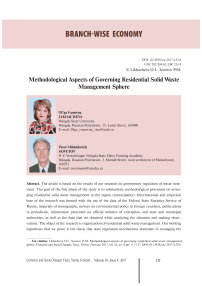Methodological aspects of governing residential solid waste management sphere
Автор: Likhacheva Olga Ivanovna, Sovetov Pavel Mikhailovich
Журнал: Economic and Social Changes: Facts, Trends, Forecast @volnc-esc-en
Рубрика: Branch-wise economy
Статья в выпуске: 4 (52) т.10, 2017 года.
Бесплатный доступ
The article is based on the results of our research on government regulation of waste treatment. The goal of the first phase of the study is to substantiate methodological provisions on arranging residential solid waste management in the region (municipality). Informational and empirical base of the research was formed with the use of the data of the Federal State Statistics Service of Russia, materials of monographs, surveys on environmental policy in foreign countries, publications in periodicals, information presented on official websites of enterprises and state and municipal authorities, as well as the data that we obtained while analyzing the situation and making observations. The object of the research is organization of residential solid waste management. Our working hypothesis that we prove is the thesis that state regulation mechanisms dominate in managing the development of waste treatment sphere and that there is a possibility of limited admission of market self-regulation tools managing residential solid waste treatment in the region (municipality)...
Residential solid waste, residential solid waste management sphere, management of residential solid waste treatment sphere, state regulation of development of residential solid waste management sphere
Короткий адрес: https://sciup.org/147223955
IDR: 147223955 | УДК: 502/504:62 | DOI: 10.15838/esc.2017.4.52.6
Текст научной статьи Methodological aspects of governing residential solid waste management sphere
People’s livelihoods are ensured by continuous extraction of various resources from the natural environment for the purpose of their use in the production process or in daily life. This implies the necessity to consider issues such as their sustainable use, and impact of such activities on the environment, including the impact caused by waste accumulation.
According to UNESCO estimates, the volume of residential solid waste increases each year, and by 2025 it will have increased fivefold compared to the 1990 level [2]. The Russian Federation annually produces over 60 million tons of residential solid waste or around 400 kg per person per year [7].
In conditions of continuously declining population, simultaneously with the increase in the volume of solid waste (Fig. 1a and 1b) and the complexity of their composition, new packaging materials are emerging derived from complex polymers, which for a long
Figure 1a. Dynamics of generation of residential solid waste in the Vologda Oblast in 2005–2015
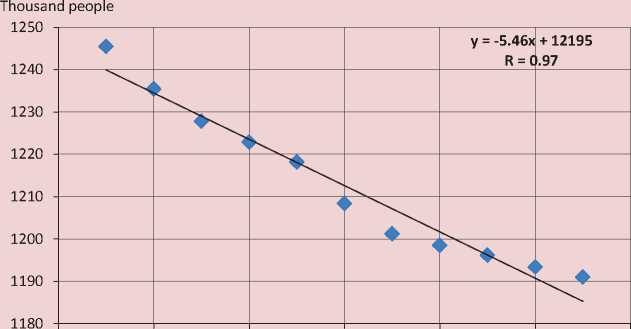
2004 2006 2008 2010 2012 2014 2016 Years
Sources: Report on the state of the environment of the Vologda Oblast. Available at: sostoyanie-okruzhayushhey-sredy; compiled by authors.
Figure 1b. Dynamics of the Vologda Oblast population in 2005–2015
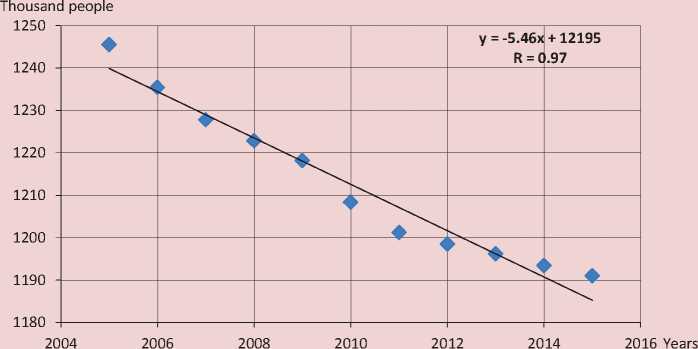
Source: Federal State Statistics Service of Russia. Available at: ; compiled by authors.
time (a hundred years or more), in certain conditions, may retain hazardous properties. However, the Federal State Statistics Service of Russia (Rosstat) does not monitor the morphological composition of residential solid waste; there are only a few regional scientific studies that consider their structure, which according to various estimates contains up to 400–500 varieties of organic and nonorganic products. Most analysts agree that the increase in the volume of residential solid waste in the Russian Federation at the reduction of its population in 1993–2013 is connected with the increased use of packaging materials.
According to the authors (A.A. Solov’ya-nova, E.M. Krivchenko, G.I. Sapozhnikova), in the total volume of waste produced in Russia, about 97% goes to landfills and dumps, and only 4–5% is recovered [14; 22; 23]. For comparison: Sweden, Denmark, Switzerland, Germany, Belgium, Norway, Austria, and the Netherlands recycle from 40 to 60% of their total waste [1; 28]. Currently in the Russian Federation there are more than 1,300 landfills, which occupy more than 40 thousand hectares. Every year about one thousand hectares of land is allocated for the construction of new residential solid waste landfills [7].
The functioning of landfills causes a whole range of environmental problems. The most important of them include negative impact on different components (both abiotic and biotic) of ecosystems around residential solid waste landfills, which poses a real threat to people’s health. However, residential solid waste is not only a source of environmental contamination, but also one of the most economical types of resources. And it is for a reason that the involvement of residential solid waste in economic turnover and the development of resource conservation are contained in the “Principles of state policy in the field of environmental development of the Russian Federation for the period till 2030” as a tool to provide environmental safety and green growth of the economy [18].
Issues such as the development of optimization methods for residential solid waste management and improvement of the economic mechanism of regulation are considered in the works of domestic and foreign scientists such as V.B. Abramov, T.A. Akimova, S.N. Bobylev, A.A. Gusev, V.I. Danilov-Danil’yan, E.V. Zakalyukina, A.V. Ivanov, K.P. Kolotyrin, G.M. Mkrtchyan, N.V. Pakhomova, K.K. Rikhter, and others. However, there is a lack of comprehensive studies on the governance of residential solid waste management sphere at the level of municipalities, cities and villages; it is becoming critically important to substantiate and choose rational models for organizing residential solid waste management in the regions (municipalities).
In this regard, the staff of the Department of Economics and Management of N.V. Vereshchagin Vologda State Dairy Farming Academy conducted a research on the problems of state regulation of development of waste management sphere. The purpose of one of the stages of the research was to substantiate a conceptual model for governing the sphere of waste management at the regional (municipal) level. To date, the problem is stated, and methodological principles for organizing waste management are worked out. The information and empirical base of the research was formed based on Rosstat data, on studying and summarizing the materials of monographs, surveys on environmental policy of foreign countries, publications in periodicals, information presented on official websites of enterprises, state and municipal authorities, as well as the data that we obtained through analysis and observations. The tools and methodology of the research include economic and statistical surveys, comparative and systemic analysis, structuring and grouping, web analysis and modeling.
Analytical review of legislative and normative legal acts of the federal, regional and municipal level, regulating relations in the field of waste management in the Russian Federation, allows us to note that federal legislation has not until recently defined the concept “residential solid waste” clearly, although the term “municipal waste” is used in the practice of state and municipal management.
The lack of unified approach to the definition of the term “residential solid waste”
entailed certain problems. First, the volume of residential solid waste produced by municipalities was estimated very conventionally. Second, difficulties arose in the calculations of the volume of potential waste that can be directed for further processing. Third, there emerged controversial evaluations of economic efficiency of management decisions in the justification of schemes for the distribution of productive forces in local systems. Fourth, there is a mismatch between organizational regulations of control over execution of requirements of regulatory legal acts in the sphere of residential solid waste management.
The national standard – GOST Р536922009 [4], which was adopted in 2009, defines residential solid waste as consumer waste generated by the population, including waste generated during cooking, cleaning and repair of residential premises, maintenance of adjacent areas and common areas, keeping domestic animals and birds in residential premises, as well as outdated, worn out household items. Later, the concept of solid waste was formulated in GOST R 56222-2014 [5] as the solid waste generated by households. However, the federal classification catalogue of waste refers residential solid waste to the group “municipal waste”.
December 29, 2014, amendments to Federal Law 89 “On production and consumption waste” were adopted; after that the concept of “municipal solid waste” was introduced. It includes the waste generated in residential premises during the process of consumption by individuals and the goods that have lost their consumer properties in the course of their use by individuals in residential premises in order to meet their personal and domestic needs. Municipal solid waste also includes the waste generated by legal entities, individual entrepreneurs and that which is similar in composition to the waste produced by individuals in residential premises in the process of consumption [17].
Thus, waste generated in the course of people’s lives and economic activity of organizations (service objects) received an official interpretation as solid communal waste. However, the definition of solid communal waste given in the current edition of the federal law does not take into account the transformation of the waste at the stages of its treatment, which leads to inaccuracies in establishing the norms of accumulation and, as a consequence, to errors in determining the volume and range of operational management decisions of state and municipal authorities.
The legislation of European Union members uses the term “municipal waste”, which covers not only residential waste but also waste produced by public catering enterprises, trade organizations, educational institutions, etc. It is typical of most EU countries to place the responsibility for waste management on city government. In fact, this marks one of the key functional powers of municipal authorities [27].
We take the liberty of suggesting a revised definition of solid waste. We believe that the main feature of waste should be not only an indication that it was formed in the process of consumption of goods, services, etc. and has lost its consumer properties, but an indication of what constitutes its structure. We understand residential solid waste as the waste that represents secondary resources, biodegradable waste, and unreclaimable waste generated in the residential sector, at enterprises and organizations of the service sector. First, it reflects the social nature of the origin of waste; second, it will help evaluate it from the viewpoint of “usefulness”.
The diversity and specific features of solid waste and its high spatial dispersion led to the need for a specific organizational and process format of displaying its place and role in the impact on human health and environment. A new object-subject-category “waste management” was introduced into the legal field of state and municipal management.
Russian GOST 30772-2001 [6] provides a definition of waste management as activity associated with a set of documented organizational and technological procedures for disposal of neutralized waste and discharges for the purpose of obtaining recoverable resources and useful products and/or destructing and burying of hazardous and other waste that is not used at present.
Western European countries use the term “waste management”, which means organizing waste handling with the aim of reducing its impact on human health and on the environment [3; 26]. This terminological position provides an opportunity to develop methodological aspects for measuring and assessing the level of social responsibility in waste management sector.
The literature and financial documents of major international institutions such as the UN (UNEP) and the World Bank, when discussing environmental issues, use the term “municipal solid waste management” – it is the planning and implementation of the system for processing municipal solid waste” [15; 28].
Thus a methodological basis is formed that represents waste management as a set of science-based targeted impacts on the collection, storage, transportation, processing, recycling, and disposal of waste to ensure environmental, economic and social standards and requirements.
It would seem that the methodological platform mentioned above suggests its use in the justification of appropriate powers of state and municipal authorities. However, taking into account the specifics of organizing waste management in Russia, solving the tasks of organizing the collection and recycling of waste is not included in the list of powers of any federal agencies that perform mainly supervisory functions (Fig. 2).
As a result, the issues of resource and environmental policies remain unbalanced, the responsibility for reducing the negative impact of waste on the environment is “spread” between the departments.
Actually, it turns out that in Russia, all stages of waste management process are governed by municipal authorities. As a rule, they transfer the execution of management decisions on organizing the collection, processing and recycling of waste to municipal unitary enterprises they themselves founded. For these enterprises, a priority task is resource saving and gaining profit at the expense of involving waste into economic circulation, as their function is to take waste away and bury it. In addition, waste management sphere is not covered by market regulation mechanism; and municipal solid waste is not subject to market transactions.
Thus, the problem of linking the tasks of optimizing the relationship between environment and economy remains with municipal governments. And legal framework does not allow them to shift the responsibility, at least partially, to the federal level: according to Articles 14-16, Federal Law 131-FZ, the powers of settlements include organizing the collection and disposal of residential waste and trash; the powers of municipal districts include organizing the utilization and processing of residential waste; and those of urban districts – organizing the collection, removal, disposal and recycling of residential waste [16].
Russian Federation Government
Figure 2. Functional subsystem of state governance of waste management sphere in the Russian Federation
State administration bodies:
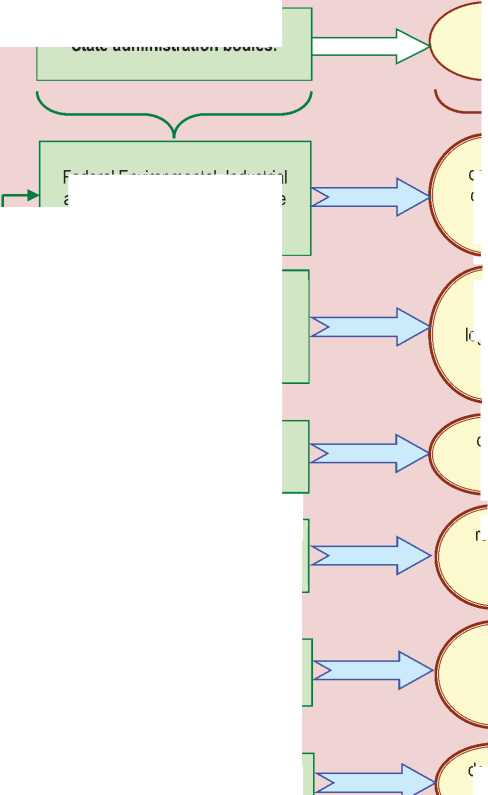
adoption of normative legal acts for the calculation of regulated tariffs in the field of waste management
* Ministry of Education and Science
Federal Antimonopoly Service
Ministry of Industry and Trade
Russian Federal Service for Surveillance on Consumer Rights Protection and Human Wellbeing (Rospotrebnadzor)
Ministry of Natural Resources and Environment
Federal Environmental, Industrial and Nuclear Supervision Service (Rostechnadzor)
Functional powers:

control and supervision of the observance of legislation in the sphere of radioactive waste management

supervision of the observance of health legislation in waste management to ensure public health safety

control and supervision in the sphere of waste management

research on and development of scientific and technological priorities in waste management


development of technologies in the sphere of waste management
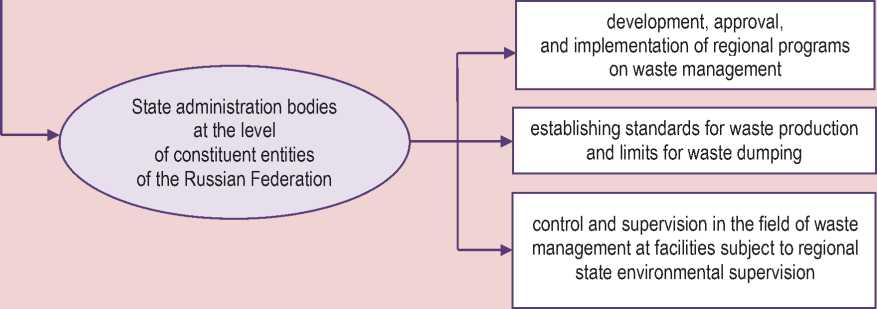
Source: compiled by authors.
Surveys of heads of municipal entities in the Vologda Oblast carried out by ISET RAS show their concern about the functioning of waste management sphere. Many of them focus on the need to use the strengths of domestic experience in the field of waste management, combining the advantages of centralized resource planning with the integrative nature of functional interaction between central, regional and local governments to ensure environmental, economic and social standards and requirements at all stages of collection, storage, transportation, processing, recycling, neutralization, and disposal of waste.
It is known that the targets of the functioning and development of waste management in the USSR were set at the allunion level by the State Planning Committee (Gosplan); resource support was carried out by the State Committee for Material and Technical Supply (Gossnab).
The task of Gosplan was to plan and control the volume of waste collection for its further use as a secondary resource. Gossnab had specialized offices responsible for acceptance of recyclable materials: Glavvtorsyr’e (Main directorate for acceptance and recycling of secondary resources), Glavvtorchermet (Main directorate for acceptance, recycling and sales of secondary ferrous metals), Glavvtortsvetmet (Main directorate for acceptance, recycling and sales of secondary non-ferrous metals). Glavvtorsyr’e collected recyclables from people in cities and rural settlements (Tsentrosoyuz (Central Union of Consumer Cooperatives) – in rural areas), Glavvtor-chermet collected scrap metal from industrial enterprises, state farms, and machine and tractor stations; Glavvtorchermet was responsible for collecting non-ferrous and precious metals. Secondary resources were used for production of new products, and the cost of collection and preliminary processing of secondary raw materials was included in its self-cost.
In the 1980s in the USSR there were 527 enterprises for production of secondary resources and 5,677 centers for collecting secondary raw materials from people, among them: 3,793 stationary and 1,884 mobile centers [9].
Gossnab also included the All-Union Scientific-Research Design and Technological Institute of Secondary Resources (VIVR), which provided scientific solutions to technological problems of recycling.
Information support of waste management sphere was based on detailed and strictly formalized statistical reporting – both general and for different categories of waste. The production plan of each company recorded the amount of waste (metal, glass, plastic, etc.) necessary to be delivered to Gossnab on a mandatory basis.
According to the Decree of the Central Committee of the Communist Party of the Soviet Union and the USSR Council of Ministers No. 608, “On radical improvement in the use of raw materials, energy and other material resources in 1986–1990 and in the period until 2000” dated May 23, 1986, the organization responsible for the development of new types of materials or products at the same time was to develop technology for reuse or recycling after the end of service life or operation, providing for the establishment of appropriate capacities along with the creation of capacities on production of new materials or products [21].
Thus, in the USSR, governing the sphere of waste management included planning, organization, coordination, regulation and control in order to achieve the main goal – to involve waste into economic circulation and to minimize its negative impact on the environment.
In the 1990s, during the transition to a market economy, the Government of the Russian Federation completely eliminated the then existing system of secondary material resources management; and the economic sector of secondary material resources processing almost collapsed. In 1996, the statistical reporting forms 14-VR (secondary resources) 14-les (wood waste), 9-SN (ferrous scrap metal), 17-SN (nonferrous scrap metal) for enterprises were abolished.
Due to spontaneous emergence of local private landfills for waste storage and enterprises engaged in waste collection, the reformers of the 1990s were convinced that the sphere of waste management could be governed by pure market regulation. Later it became obvious that it was necessary to use state regulation tools that were partially outlined at the beginning of the 2000s when forming a decentralized model for governing waste management sphere at the municipal level.
Meanwhile, most industrialized countries acknowledge and use an integrated model for governing waste management sphere, which is characterized by the borrowing of methodological principles, individual tools and forms of governance, approved previously in the USSR. So, in the EU, the responsibility for waste management is concentrated at the national level with specially authorized agencies. In Sweden, it is the Ministry of the Environment and Energy, in France – the Ministry of Ecology, Sustainable Development and Energy, in Denmark – Environmental Protection Agency, in the UK – the Department of the Environment, Transport and the Regions, in Austria – the Federal Ministry of Agriculture, Forestry, Environment and Water Management, etc.
The European Union for a long period of time purposefully and consistently formed a unified system of regulations on industrial and residential waste management (Fig. 3) . To
Figure 3. Legal basis for waste management in the EU
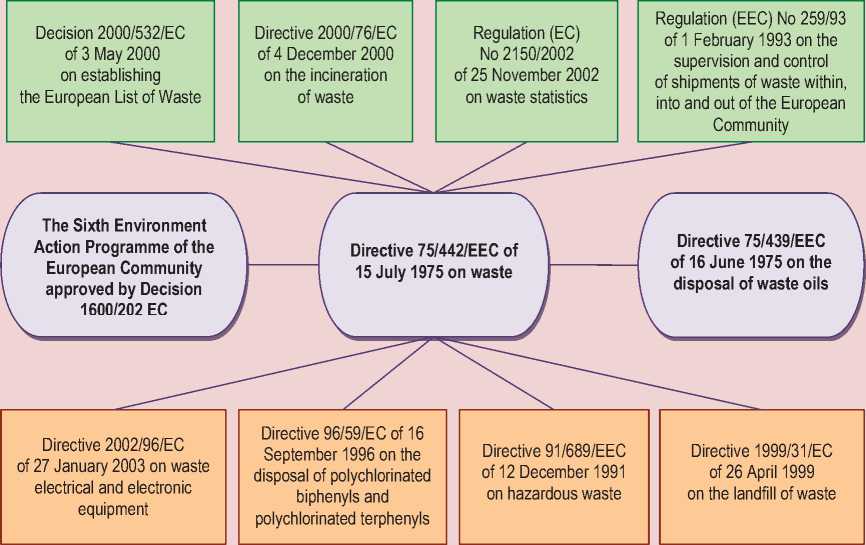
Source: Pinaev V.E., Chernyshev D.A. Regulirovanie deyatel’nosti po obrashcheniyu s otkhodami – opyt Evropeiskogo soyuza [Regulation of waste management – the experience of the European Union]. Internet-zhurnal “Naukovedenie” [Online journal “Science studies”], 2014, no. 4. Available at:
date, EU member states have an established practice of state regulation of the level of collection and recycling of common types of waste; unfortunately, there is no such practice in the current organization of governing the sphere of waste management in the Russian Federation.
One more principle that the USSR applied is now used by different countries in their state and municipal management; this principle is known as “extended producer responsibility”, i.e. the liability of producers (entrepreneurs)
for collecting and recycling their products and packaging [24; 25].
In Austria, Belgium, Finland, Germany, Luxembourg and Sweden, the responsibility for the disposal of individual types of waste is entrusted entirely to specialized organizations, and municipalities do not bear the costs of waste collection. In Ireland, Italy and Spain, manufacturers of goods pay fees to local authorities for collecting waste, and the fee is later allocated to waste disposal activities [11; 13].
Figure 4. Participants in the system of solid waste management and their functions
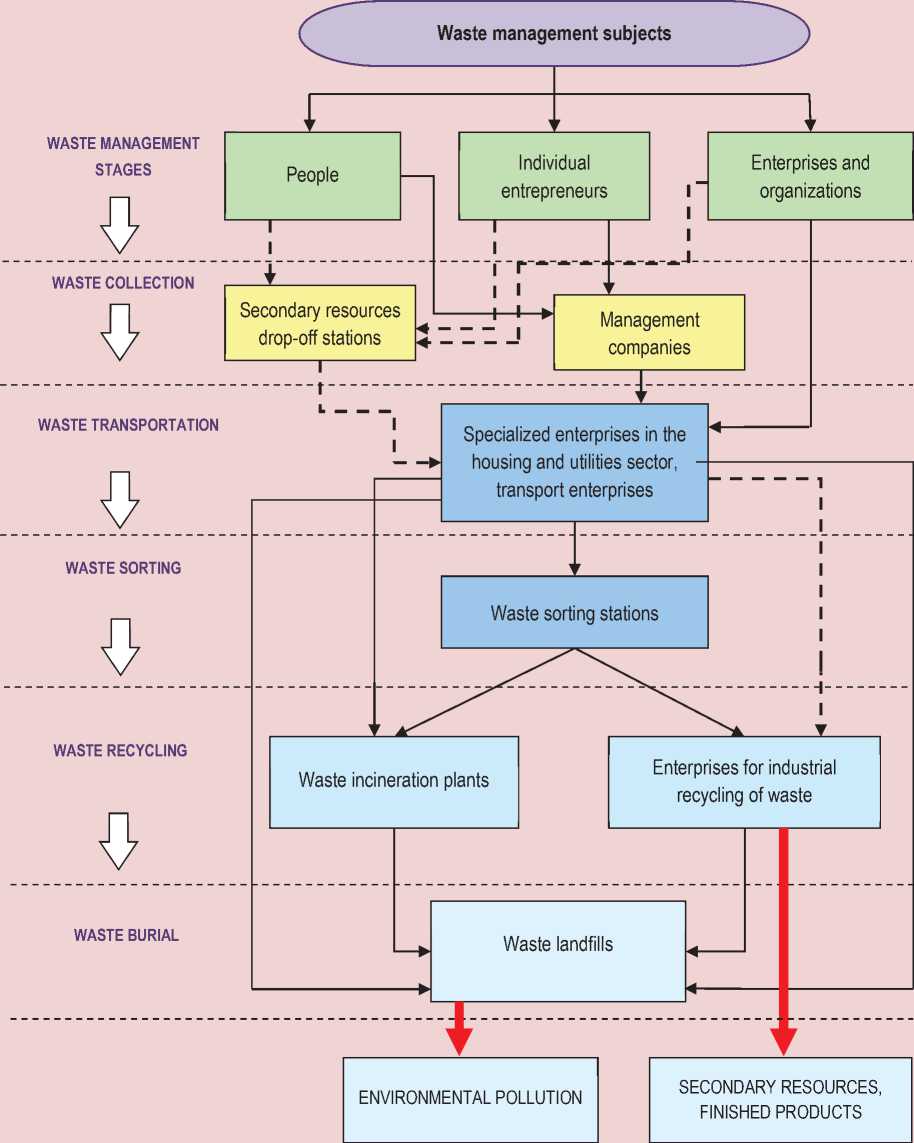
----------► Waste movement without preliminary sorting
^^ ^^ ^^ ^^ ^^ Waste movement with preliminary sorting Source: compiled by authors.
The Soviet and Western European experience of governing the sphere of waste management described in the scientific literature indicate the possibility of jointed action by all stakeholders: residents, housing and communal services, enterprises that collect and transport waste, waste recycling companies, administrations of municipalities, cities and settlements, state and federal authorities, and environmental associations.
Systematization of the data on the status and functioning of the sphere of residential solid waste management on the materials of the Vologda Oblast allows us to regard it as a system (Fig. 4) that has structural and functional imbalance of its stages in a single technological process, inconsistent regulations of interaction between its participants and the inconsistency of their economic interests in the absence of a unified state coordinator. There is an obvious need not only to focus attention on general problems of this complex sphere, but also to specify some of them for the purpose of implementing urgent management actions.
Thus, according to statistical reporting form No. 2-TP (waste), the state register of waste disposal facilities in the oblast as of January 1, 2015 contains 31 facilities for burying communal solid waste [8]. However, in 2015, after the implementation of organizational and supervisory measures, 2,359 sites of unauthorized waste dumps and garbage pilings were revealed [10], which were not governed by regional authorities (in terms of accounting and assessing their negative effects, calculations of costs of eliminating them or performing other reasonable operations), including information about the responsibility of specific actors.
Another line of action is to elaborate institutional and legal regulations that would help create not only large and specialized enterprises for waste processing, but also a corresponding local network of small and micro enterprises and specific individuals (existing and potential), covering the preparation stage of the process of manufacturing recycled resources. Probably it does not require the use of high technology to organize, for example, separate waste collection, which in the regional center and in the adjacent district is implemented only on a few sites and could potentially be organized at least in all rural and village municipalities in terms of currently functioning 32 companies and enterprises specializing in the processing of waste (plastics, rubber, waste paper, tires, metals, etc.).
It would be advisable to revise the existing regional tariff policy in the sphere of collection and removal of residential solid waste (there is a wide range of tariffs for removal and disposal of solid waste in various municipalities – from 39.16 rubles to 616.8 rubles) [19]. It remains unclear how much consideration is given in the differentiation of tariffs to the utility of residential solid waste for the production of secondary resources. There is an imperative need for changes in the tariff system in the sphere of solid waste management at the regional level, which should serve, according to the opinion of A.V. Ivanov, as an incentive to organize separate waste collection [12].
It is necessary to consider economic motivation of the subjects participating in the process of solid waste management and enterprises that consume recycled resources.
Having analyzed and considered issues concerning the functioning of the sphere of residential solid waste, having reviewed domestic and foreign experience of waste management, we can draw a conclusion that it is possible to solve these problems consistently on the basis of system approach to governing this sphere with the increased use of program-target tools for state regulation of development.
Methodological basis for developing an integrative model for governing the sphere of residential solid waste management in municipal areas is provided by representing the process of governing the sphere of waste management as a combination of sciencebased targeted impacts on the collection, storage, transportation, processing, recycling, utilization, and disposal of waste to ensure environmental, economic and social standards and requirements.
Список литературы Methodological aspects of governing residential solid waste management sphere
- Anopchenko T.Yu., Kirsanov S.A., Chernyshev M.A. Zarubezhnyi opyt upravleniya v sfere tverdykh bytovykh otkhodov . Rossiiskii Akademicheskii zhurnal , 2014, vol. 27, no. 1, pp. 8-14..
- Ashikhmina T.V. Geoekologicheskii analiz sostoyaniya okruzhayushchei sredy i prirodookhrannye rekomendatsii v raione raspolozheniya poligonov TBO Voronezhskoi oblasti : dis. … kand. geogr. nauk: 25.00.36 : Ph.D. in Geography dissertation]. Voronezh, 2014. 187 p..
- Volynkina E.P., Kuznetsov S.N. Analiz modelei upravleniya otkhodami i razrabotka integrirovannoi modeli dlya regional'nogo upravleniya tverdymi bytovymi otkhodami . Vestnik Sibirskogo gosudarstvennogo industrial'nogo universiteta , 2013, no. 3 (5), pp. 47-59..
- GOST R 53692-2009 Resursosberezhenie. Obrashchenie s otkhodami. Etapy tekhnologicheskogo tsikla otkhodov . Konsul'tant Plyus: sprav.-pravovaya sistema ..
- GOST R 56222-2014 Resursosberezhenie. Obrashchenie s otkhodami. Terminy i opredeleniya v oblasti materialov . Konsul'tant Plyus: sprav.-pravovaya sistema ..
- GOST 30772-2001 Resursosberezhenie. Obrashchenie s otkhodami. Terminy i opredeleniya. . Konsul'tant Plyus: sprav.-pravovaya sistema ..
- Gosudarstvennyi doklad "O sostoyanii i ob okhrane okruzhayushchei sredy Rossiiskoi Federatsii v 2014 godu" . Available at: http://mnr.gov.ru.
- Gosudarstvennyi reestr ob"ektov razmeshcheniya otkhodov . Available at: https://e-ecolog.ru/groro/region/35.
- Devyatkin V.V. Upravlenie otkhodami: otechestvennyi i zarubezhnyi opyt . Ekologicheskii vestnik Rossii , 2009, no. 2, pp. 37-41..
- Doklad o sostoyanii i okhrane okruzhayushchei sredy Vologodskoi oblasti v 2015 godu . Vologda: Sad-ogorod, 2016. 232 p..
- Dorozhko S.V., Gnedov A.N., Kalinovskaya I.A. Upravlenie tverdymi bytovymi otkhodami: nauchno-prakticheskoe izdanie . Minsk: Orekh, 2010. 214 p..
- Ivanov A.V. Teoriya i metodologiya formirovaniya sistemy upravleniya infrastrukturnymi kompleksami (na primere sistemy upravleniya tverdymi bytovymi otkhodami) : dis. … doktora ekon. nauk: 08.00.05 : Doctor of Geography dissertation]. Saint Petersburg: GOU VPO "Sankt-Peterburgskii gosudarstvennyi universitet ekonomiki i finansov", 2009. 561 p..
- Kirsanov S.A., Mustafin G.V. Mirovoi i rossiiskii opyt utilizatsii tverdykh bytovykh otkhodov . Vestnik Omskogo universiteta. Seriya "Ekonomika" , 2014, no. 2, pp. 114-120..
- Krivchenko E.M. Sovershenstvovanie sistemy ekologo-ekonomicheskogo upravleniya otkhodami: avtoref. dis. … kand. ekon. nauk: 08.00.05 . Moscow: TsEMI RAN, 2007. 25 p..
- Nazarov A.I. Upravlenie tverdymi otkhodami v sub"ekte federatsii . Available at: http://waste.ru›…library/nazarov_upravlenie_othodami.pdf.
- Ob obshchikh printsipakh organizatsii mestnogo samoupravleniya v Rossiiskoi Federatsii: feder. zakon ot 06.10.2003 №131-FZ . Garant-servis: sprav.-pravovaya sistema ..
- Ob otkhodakh proizvodstva i potrebleniya: feder. zakon ot 24.06.1998 № 89-FZ . Garant-servis: sprav.-pravovaya sistema ..
- Osnovy gosudarstvennoi politiki v oblasti ekologicheskogo razvitiya Rossii na period do 2030 goda (utv. Prezidentom RF ot 30 aprelya 2012 g.) . Available at: httr://base.garant.ru.
- Ofitsial'nyi sait Departamenta toplivno-energeticheskogo kompleksa i tarifnogo regulirovaniya Vologodskoi oblasti . Available at: http://www.vologdarec.ru/tarifs?Rajon=1973&MO=19730000&Group=0&Period=0.
- Pinaev V.E., Chernyshev D.A. Regulirovanie deyatel'nosti po obrashcheniyu s otkhodami -opyt Evropeiskogo soyuza . Internet-zhurnal "Naukovedenie" , 2014, no. 4. Available at: http://naukovedenie.ru/sbornik6/4.pdf.
- Postanovlenie TsK KPSS i Soveta Ministrov SSSR ot 23 maya 1986 g. № 608 "O korennom uluchshenii ispol'zovaniya syr'evykh, toplivno-energeticheskikh i drugikh material'nykh resursov v 1986-1990 godakh i v period do 2000 goda" ..
- Sapozhnikova G.P. Konets "musornoi tsivilizatsii": puti resheniya problemy otkhodov . Moscow: Oksfam, 2010. 108 p..
- Solov'yanov A.A. Utilizatsiya otkhodov v Rossiiskoi Federatsii . Available at: http://russiancouncil.ru/inner/?id_4=3558#top-content.
- Bani M.S., Rashid Z.A., Hamid K.H.K. et al. The Development of Decision Support System for Waste Management. World Academy of Science, Engineering and Technology, 2009, no. 25, pp. 161-168.
- Gentil E.C. Life-cycle modelling of waste management in Europe:tools, climate change and waste prevention: PhD Thesis. Department of Environmental Engineering Technical University of Denmark, 2011. 57 p. Available at: http://orbit.dtu.dk/fedora/objects/orbit:85800/datastreams/file_5478313/content
- Cleary J. The incorporation of waste prevention activities into life cycle assessments of municipal solid waste management systems: methodological issues. The International Journal of Life Cycle Assessment, 2010, no. 15, pp. 579-589.
- Murrey R. Tsel' "Zero Waste" . Translated from English. Moscow: OMNNO "Sovet Grinpis", 2004. 232 p.
- Managing municipal solid waste -a review of achievements in 32 European countries. EEA Report No. 2/2013. Luxembourg: Publications Office of the European Union. Available at: http://eea.europa.eu›…municipal-solid-waste/download

